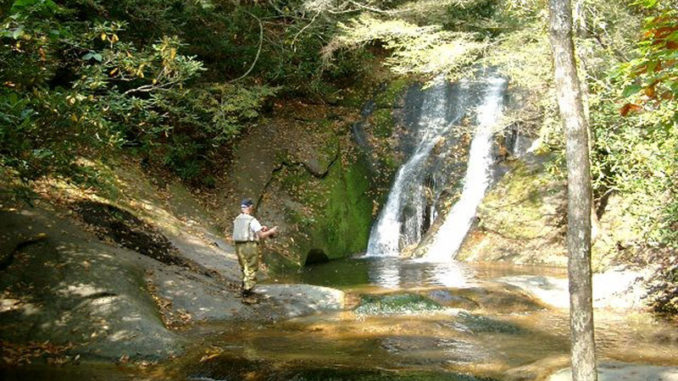
Wild and beautiful places. Wild and beautiful fish. It’s enough to keep an angler addicted for life.
Why do I love trout fishing? Let me count the ways.
Trout fishing isn’t just about catching trout. It’s also about the places you go to fish for trout. Places such as the Pisgah and Nantahala national forests in North Carolina, the Sumter National Forest in South Carolina, the Great Smoky Mountains National Park, the Blue Ridge Parkway, state parks in North Carolina and South Carolina, the Jocassee Gorges and Mountain Bridge Wilderness Area in South Carolina.
Trout thrive in these wild and beautiful places.
A dedicated trout fisher could fish a different stream every week and never get to all the 4,000 miles of trout streams in western North Carolina, several hundred miles of trout streams in Upstate South Carolina and 700 miles of trout streams in the Great Smokies Park.
What a glorious quest that would be.
The Trout
The brook trout is the only true native trout in the Southern Appalachians. They’ve been here for at least 11,000 years, surviving the Ice Age, surviving the loggers, the developers, invasive species, pollution and a multitude of other man-created obstacles. They survive with only minimal help from man.
Rainbow trout from western states were stocked in streams in the Southern Appalachian and eastern United States in the late 1800s and early 1900s. Brown trout were brought from Germany and Scotland in the late 1800s. They provide a viable fishery. But they depend on the same resources as brook trout. And they are far more aggressive.
The Scenery
Trout fishing has no calendar restrictions, and each season brings its own palette. Hundreds of different wildflowers fill stream banks and roadsides in spring and summer, followed by the splendid colors of fall and, finally, the stark beauty of winter. Trout are always there, regardless of the season.
Rare is the mountain stream that doesn’t have waterfalls, some quite spectacular, such as Whitewater Falls, which cascades 411 feet off a rocky cliff into Whitewater Creek in Transylvania County, N.C.; Rainbow Falls on the Davidson River, also in Transylvania County; Raven Cliff Falls, a 420-foot cascade in Caesars Head State Park, S.C.; and Twin Falls/Eastatoe Falls, side-by-side falls on Reedy Creek in Pickens County, S.C.
Catching Trout
When I fish for the pure joy of trout fishing, I fly fish. Seeing a trout rise to a man-made concoction of thread, feathers, fur and steel, watching it leap from the stream and tail-dance, is a heart-thumping, adrenaline rush that never diminishes, no matter how often I fish.
But I’m not a purist. If the occasion calls for it, I use live bait without a twinge of guilt. Such outings are limited to hatchery-supported waters, and I fish for food. Hatchery trout are raised from eggs, and when big enough, they are stocked in streams throughout the Carolinas. As much as biologists try to emulate wild fish, stockers still are stockers.
Eating Trout
I do love a good trout dinner, and a trout fried to golden perfection is a gustatory delight, even if it’s a stocker.
A few years ago, I read a short work of fiction by novelist Amy Tan, in which she described eating cheek meat from fish, which is considered a delicacy among Asians. Cheek meet is a small, wafer-like piece of meat located behind a fish’s eyes. Since reading Tan’s story, I always eat the cheek meat first.
Trout fishing is one of those rare activities that gives so much pleasure and requires so little in return.

